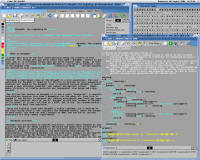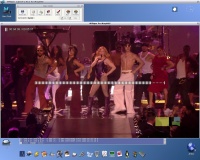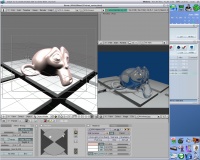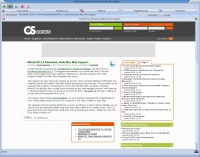Difference between revisions of "Compatibilité entre Plate-forme"
From MorphOS Library
Thebucheron (talk | contribs) |
Thebucheron (talk | contribs) |
||
| Line 7: | Line 7: | ||
| − | [[File:MPlayer.jpg|200px|thumb|left|An old version of MPlayer on MorphOS]][[File:Blender.jpg|200px|thumb|left|The 3D modeling and rendering program Blender]] | + | [[File:MPlayer.jpg|200px|thumb|left|An old version of MPlayer on MorphOS]][[File:Blender.jpg|200px|thumb|left|The 3D modeling and rendering program Blender]]Quand AmigaOS a été conçu, un certain nombre de structures et de caractéristiques ont été inspirées par Unix, et naturellement on les retrouvent dans "l'ABox", l'API de MorphOS. Ainsi la conversion de commandes shell, utilitaires, programmes, et jeux d'Unix à AmigaOS, et maintenant de Linux à MorphOS, n'est parfois pas difficile. Deux bibliothèques système spécifiques ("ixemul.library" et "ixnet.library") permettent de faciliter la conversion de programmes exigeant des routines spéciales Linux. Même de grandes et complexes applications comme "MPlayer", "MEncoder", "MLDonkey", "E-UAE", "MAME", "Blender", ont été portées sur MorphOS. |
The main obstacles for code porting are the absence of the ''fork()'' function in AmigaOS and the ''ABox'' of MorphOS, the fact that AmigaOS/MorphOS are not fully POSIX-compliant, and the extreme difficulty of GUI porting. Linux GUIs are based on windowing systems which are usually parts of larger desktop environments, and are not integrated in the OS. Besides a very early port of ''X-Windows'', no Linux windowing system has ever been ported to AmigaOS/MorphOS. There is no real advantage in doing such a port, because the effort would be very hard, and the smallest windowing system for Linux is a few times larger than MorphOS as a whole. Easy GUI porting would require the complete loss of the small footprint character of MorphOS, and would transform it into a useless new Linux-like OS. | The main obstacles for code porting are the absence of the ''fork()'' function in AmigaOS and the ''ABox'' of MorphOS, the fact that AmigaOS/MorphOS are not fully POSIX-compliant, and the extreme difficulty of GUI porting. Linux GUIs are based on windowing systems which are usually parts of larger desktop environments, and are not integrated in the OS. Besides a very early port of ''X-Windows'', no Linux windowing system has ever been ported to AmigaOS/MorphOS. There is no real advantage in doing such a port, because the effort would be very hard, and the smallest windowing system for Linux is a few times larger than MorphOS as a whole. Easy GUI porting would require the complete loss of the small footprint character of MorphOS, and would transform it into a useless new Linux-like OS. | ||
Revision as of 10:28, 20 May 2016
Quoi qu'il en soit, quand une plateforme informatique a une petite base d'utilisateurs comme MorphOS, le développement de nouveaux logiciels devient difficile. La production de logiciel commercial n'est pas encouragée, puisqu'il n'y a qu'une petite probabilité de trouver un nombre suffisamment grand d'acheteurs. La production de logiciel Open Source et de shareware est constante, ou augmente très lentement, parce qu'elle ne trouve pas une base suffisamment grande de codeurs : chacun étant déjà concentré sur un certain nombre de projets ne leur laissant pas de temps pour d'autres. Dans ces conditions, il existe une solution qui parfois peut réduire considérablement le temps d'élaboration d'une application : la conversion d'un logiciel issu d'une autre plateforme.
The main obstacles for code porting are the absence of the fork() function in AmigaOS and the ABox of MorphOS, the fact that AmigaOS/MorphOS are not fully POSIX-compliant, and the extreme difficulty of GUI porting. Linux GUIs are based on windowing systems which are usually parts of larger desktop environments, and are not integrated in the OS. Besides a very early port of X-Windows, no Linux windowing system has ever been ported to AmigaOS/MorphOS. There is no real advantage in doing such a port, because the effort would be very hard, and the smallest windowing system for Linux is a few times larger than MorphOS as a whole. Easy GUI porting would require the complete loss of the small footprint character of MorphOS, and would transform it into a useless new Linux-like OS.
So, contrary to other platforms, AmigaOS/MorphOS never had a port of very large and important applications like Mozilla and Open Office. The absence of programs like these, that are fundamental for a normal user who wants to interface his computer with the whole cyberworld without compatibility problems, is the biggest obstacle for a larger adoption of MorphOS in the desktop computer market.
Once people recognised the uselessness of porting large pieces of Linux distributions to MorphOS, a better idea emerged: the creation of wrappers that relate all the calls to certain basic structures of one system to their equivalents in the other system. As mentioned above, one attempt in this direction concerns GTK (the GIMP Toolkit, where GIMP is the acronym of GNU Image Manipulation Program), and tries to relate this popular widget toolkit for creating GUIs for the X-Windows system to the corresponding widgets of MUI. Anyway, the most relevant current port is the MorphOS version of the Origyn Web Browser (OWB), which is - like Apple's Safari - based on the WebKit engine and thus provides MorphOS users with a state-of-the-art browser. Again the MorphOS version is not just a quick recompile but diligently integrated into the overall look & feel of the operating system (including ARexx support), providing all the common user's needs like cookie and password management, support for different languages and mime types, content blocking, configurable context menus e.g. displaying recently closed tabs and visited sites, session saving/restoration and also a Flash-plugin based on the MorphOS port of swfdec.


